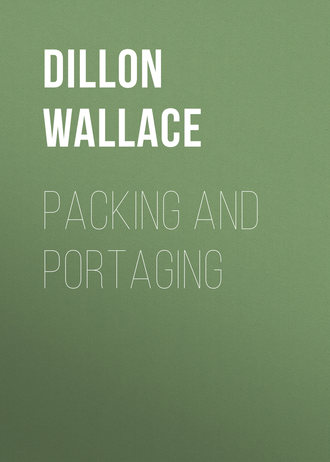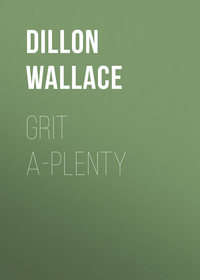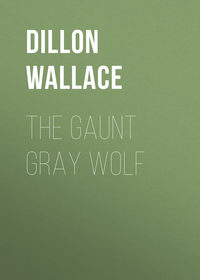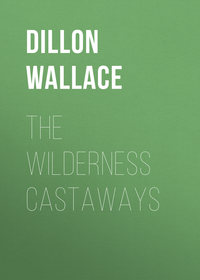 полная версия
полная версияPacking and Portaging
CHAPTER XV
WITH DOGS AND KOMATIK
IN considering equipment for dog and sledge traveling, we must constantly bear in mind the necessity of keeping down weight and bulk. Not long since, while visiting the establishment of a New York City outfitter, I saw an equipment which a sportsman ambitious for experience with dogs and komatik (sledge) had selected for a month's journey which he was about to undertake. Exclusive of provisions there was enough material to weight down four eight-dog teams. Among other things was a specially designed tent stove that would have tipped the scales at upwards of one hundred pounds.
The would-be traveler declared with pride that he "did not intend to have cold camps." It certainly gave me "cold feet" to contemplate his outfit. It was the most ridiculous and impracticable conglomerate aggregation of camping material that I have ever seen put together, and I doubt if the would-be traveler ever found a sufficient number of dogs at any one point to transport it.
While it is the aim of every experienced camper to obtain the greatest degree of comfort of which circumstances will admit, the voyager with dogs cannot hope to carry with him the luxuries of a metropolitan hotel, and one soon learns how little after all is really necessary to make one comfortable.
How much weight a team of eight good dogs can haul depends upon the character of the country and the condition of the snow or ice. Under very favorable conditions I have seen such a team make good progress with twelve hundred pounds. Ordinarily, however, eight hundred pounds is a full load, and if much rough ice, hilly country or soft snow is encountered six hundred pounds will be found all too heavy. I have heard of cases, when traveling was exceptionally good, of dogs covering upwards of one hundred miles a day. The biggest day's travel I ever made with dogs was sixty miles, but often I have toiled day after day, pulling and hauling with the animals at the traces, lifting the komatik over rough places, or packing a trail for the team with my snowshoes, to find myself rewarded with less than ten miles when camping time arrived.
In selecting outfit the region to be visited will be a factor to take into consideration. It would be quite impossible to discuss adequately in a single chapter all the phases of dog travel to be provided for. We shall therefore leave out of consideration polar outfitting, or outfitting for other unusual work, which the reader of this will scarcely be likely to undertake.
The clothing suggested in the chapter on snowshoe and toboggan travel is equally well suited to travel with dogs and komatik. Should the voyager's ambition, however, draw him within the sub-arctic regions or across the Arctic Circle some additional protection will be needed.
In the far Arctic the natives wear trousers of either polar bear skin or caribou skin, with an upper garment of caribou skin called, in Greenland, the "kulutar;" in Labrador, the "kulutuk." The only difference between the adickey and the kulutuk is that the one is made of cloth, the other of caribou skin. In Ungava I supplied myself with caribou skin trousers, which, as is the custom there, I drew on over my moleskin trousers in windy or intensely cold weather.
The kulutuk takes the place of the moleskin adickey. That is to say, the kersey adickey worn under the kulutuk will be found ample protection in any weather, and often the kulutuk of itself will be found sufficient.
Kulutuk and skin trousers are worn hair side out. Were they worn with the hairy side in, they would accumulate moisture exuded by the body, and the moisture would freeze, presently transforming the hair into a mass of ice. A friend of mine going to the Arctic for the first time as a member of one of Peary's early Greenland expeditions, turned his kulutuk inside out and donned it with the hairy side next the body. The Eskimos laughed, and resenting their levity he assured them it was much warmer worn in that manner than as they wore it. "No," said one of them, "if it were warmer worn that way the animals would wear their fur inside." My friend quickly learned by experience the logic of the Eskimo's argument.
Deerskin kulutuk and trousers are not easily purchased, though along any coast where seals are captured similar garments of sealskin may be procured, which, though not equal to deerskin garments, answer very well. The skin of the young harbor seal (the ranger seal) is best for the purpose, as skins of other species are too thick and heavy. When made of sealskin the upper garment is called a "netsek."
I discovered when traveling among them that some of the Moravian missionaries of the Labrador coast wore a buckskin suit under their ordinary trousers and outer shirt. Such a suit is much lighter than deerskin trousers and kulutuk, and serves nearly as well. It is not difficult to purchase buckskin from which one may have such a suit made. It is wind-proof and very light.
All skin garments, including moccasins, should be sewn with animal sinew. Ordinary thread will quickly break out and will not do. Thread-sewn moccasins are factory-made, and will give very little service.
The types of snowshoes suggested in the chapter on snowshoe and toboggan travel are the types also best suited to dog and komatik work. Long snowshoes would be very much in the way when one has to go to the traces and haul with the dogs or lift and assist the komatik over rough places; and this becomes the rule rather than the exception as one goes North.
Let me insist that the web should be of good caribou babiche, and not the ordinary rawhide used in many of the snowshoes offered for sale. The former will not stretch when wet, while the latter will stretch and bag so badly as to render the snowshoe practically useless.
It is well to wrap the frame on either side where the babiche is drawn around it, with buckskin or sealskin. Otherwise even a slight crust upon the snow will in time cut the babiche strands. Wrapping the snowshoe in this manner will at least double its life.
What was said in reference to tent, small sheet-iron stove and general camp and cooking outfit in the previous chapter will apply here, as well as directions heretofore given for packing in waterproof bags. In selecting the sleeping bag, give first preference to one of deerskin.
In a barren region where firewood is not to be had, it will be necessary to carry an alcohol or kerosene burner and stock of fuel. The former is preferable on account of the low freezing point of alcohol. Alcohol or oil should be secured in tin cases. It is regularly put up in this way by dealers.
In such a region, too, it may be necessary to carry snow knives with which to cut blocks of snow for the erection of snow igloos as shelter. These knives resemble somewhat the machete. One cannot, however, learn to build a snow igloo properly without long practice. This phase of the work is merely referred to as interesting; for anyone traveling in a country where snow house shelter is necessary will secure the assistance of a native, who will attend to proper sledge outfitting at the point of departure.
On regular lines of dog travel opportunities to renew the provision supply will frequently occur, and cabins for night shelter will be found. Therefore the food outfit will depend upon the country to be traversed. Where long stretches occur between supply points, however, fat pork, pilot bread, tea and sugar should form the basis. The very best possible food, however, for this work is pemmican, pilot bread, tea and sugar. Of course a little coffee may be carried, but it is bulky.
The traveler will make his selection carefully, building around pork, pilot bread and pemmican with other articles of food like desiccated vegetables from which water has been eliminated. Too much salt meat opens the door to scurvy, unless sufficient variation in the way of vegetables, fish, or fresh meat is introduced. Dessicated cranberries are an excellent preventive. A man can do good hard work day in and day out, as already stated, upon one pound of pemmican and a quarter pound of pilot bread as a daily ration, and such a ration offers no danger of scurvy.
Dog pemmican is the best dog food, and the lightest, for dogs will do pretty well upon one pound of pemmican each a day. To do well the animals should be given plenty of fat, when pemmican is not available, though not a clear fat diet, for that will make them sick. Three-quarters of a pound of fat and three-quarters of a pound of meat or fish is an ordinary ration. Dogs are fed but once a day—at night.
The number of dogs in a team varies, but the average team is composed of seven or eight. Eight or nine is the most economical number so far as results are concerned.
In the Northwest dogs are harnessed tandem. This is the white man's method. In the Northeast they are harnessed fan fashion—the Eskimo method. That is to say, each dog has an individual trace secured to the end of a single thong, leading out from the bow of the komatik and called the bridle. The individual traces are of various lengths. The dog with the longest trace is the leader of the pack, and particularly trained to respond to the driver's directions. The other dogs will follow his lead.
For open country and sea ice travel the Eskimo method is probably best, as the work is more evenly distributed and the driver can always tell whether each dog is doing his share of the work, but for narrow trails and woods travel the tandem method is more practicable.
Dogs are good, bad and indifferent. One seldom has an opportunity to pick one's dogs discriminately, and rarely may one purchase them outright unless contracted for a year in advance, for the native dog owner seldom maintains animals in excess of his requirements in the ordinary routine of his life. The traveler will usually be able, however, to hire a team by employing the owner to drive it, and the owner of a team will get much more work out of his dogs than a stranger to the dogs can hope to do.
At least a year's experience is necessary to enable a white man to handle a dog team with anything approaching efficiency, and even then one cannot hope to approach the performance of an Eskimo. The failure to enlist Eskimos as dog drivers has been the real cause of the failure of many an Arctic expedition.
It is advised, then, that the traveler employ at so much per day or for the trip driver and dogs. It is an unsafe experiment to start off with a dog team unattended by an experienced man. The owner of the team will supply also the necessary dog harness, his own dog whip and general dog traveling paraphernalia, including the komatik.
Sledges or komatiks vary in different localities as to width, length and minor methods of construction. The average komatik is two feet wide and ten feet long but as stated, they vary in different localities, a uniform width being maintained to suit the local conditions of the region in which they are used. For example, wide and comparatively short komatiks are employed in Quebec, while the Ungava komatik is but sixteen inches wide. These latter komatiks are usually fifteen or sixteen feet in length, however. The runners stand ten inches high. This is, in fact, the heaviest and most efficient komatik I have ever seen. Each runner is made from a single piece of timber and is from two and one-half to three inches thick. It is designed for the roughest possible use, and is, I believe, better adapted to this purpose than the Greenland komatik because more substantially built. The latter is peculiar in that it has upstands at the rear for guiding it.
Crossbars, extending an inch or so on either side of the runners and from one to two inches apart, are lashed into place with rawhide. When the rawhide shrinks the komatik becomes firm. Iron fastenings being rigid would break too readily, particularly in intense cold, to be reliable.
The traveler will do well, therefore, to purchase if he does not hire his komatik at the point of departure, as in so doing he will secure one of correct design for the region to be traversed.
It is well to have a box made the width of the komatik two or three feet long, and about fourteen inches deep to lash upon the rear end of the komatik in which cooking utensils and a portion of the food supply, as well as odds and ends, may be carried. This should be supplied with a hinged cover, and hook or clasp by which the cover may be securely fastened down.
The best lash for securing the load in position is one of sealskin, though ordinary hemp rope will do. Before lashing, the tarpaulin should be neatly folded over the top of load to protect it.
One end of the lash is secured to an end of the crossbar at the forward end of the load, brought across the load and under the other end, then across, skipping a couple of crossbars, and back again skipping a couple of crossbars, thus threading it from side to side under the ends of every second or third crossbar to the rear bar, where it is brought across the load to the opposite end of this crossbar and crisscrossed across the load again to the forward crossbar to be tied.
THE END



